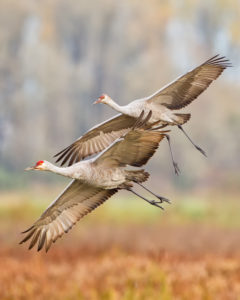
Many of you who follow our E-newsletter might be a little confused. Usually we highlight the Sandhill Crane in the fall, when their migratory routes bring them back for some rest in Ridgefield, and we celebrate that return with the BirdFest & Bluegrass festival. Well this year is apparently one for many changes and new beginnings, and Ridgefield National Wildlife Refuge is not exempt from that.
For the third time it has been recorded that a Sandhill Crane pair has taken up residence along the lower Columbia River to try and raise a Colt (young Sandhill Crane). Historical

Refuge documents from 1985 noted that several years’ prior, a crane was observed with a fledgling on Bachelor Island. Then in 2002, an employee of the Oregon Department of Fish and Wildlife observed cranes with a colt on Sauvie Island, OR. Now, we have a pair in the Kiwa Trail area of the River ‘S’ Unit. In case you missed it, you can learn more about this sighting, and how exciting it is, straight from our acting Refuge Manager, Eric Anderson, in last month’s enews here.
Sandhill Cranes are endangered in Washington state, and Sandhill Crane populations recover slowly, partly because each breeding pair usually has only one chick per year that survives to fledging. The future of Sandhill Cranes is mainly tied to the fate of their habitat. It’s particularly important to conserve wetlands in the ranges of nonmigratory populations, and in staging and wintering areas where large migratory flocks congregate.

Sandhill Cranes also mate for life, putting on their well-known mating displays of dancing through the shallow water, dipping, bowing, and even throwing sticks and other vegetation. After the dancing and the nest is built, and a Sandhill Crane chick hatches, it can begin to move around, leave the nest, and start swimming within 8 hours. Family units will stay together until the 9 or 10-month old colt separates from its parents, but they don’t go too far. During migration and winter, the family units group together with other families and nonbreeders, forming loose roosting and feeding flocks—in some places numbering in the tens of thousands—which is what we celebrate in October.
These cranes are omnivores, and while their favorite food is the corn leftover in fields that have been harvested, they will also eat berries, tubers, and some small invertebrates and vertebrates. Depending how long they stay in one place, they will also eat snails, reptiles, amphibians, nestling birds, and small mammals.
You can differentiate Sandhill Cranes from Great Blue Herons and Great Egrets on our Refuge by size, coloring, and call. Sandhill Cranes are the largest of the three- by quite a bit, and are grey/brown with rust crimson colored caps. Their call is very distinct, and when the groups of them are calling together, it can be quite a cacophony of incredible sound. This loud, rolling, trumpeting call is a unique tone, and a product of anatomy: Sandhill Cranes

have long tracheas (windpipes) that coil into the sternum and help the sound develop a lower pitch and harmonics that add richness.
As Eric Anderson has pointed out, Sandhill Cranes are generally very shy, and easily disturbed from the nest. Too many check-ins to their nest could result in total nest abandonment, which includes any eggs. To prevent this from happening, the Refuge has opted to keep the Kiwa Trail area of the Refuge closed, even if and when covid-19 restrictions are lifted. This nesting attempt is of great significance to both the Refuge and our partners in wildlife management. Please respect the trail closure in the interest of protecting the cranes. We will provide as many updates as we can.
Did You Know? Although some start breeding at two years of age, Sandhill Cranes may reach the age of seven before breeding.